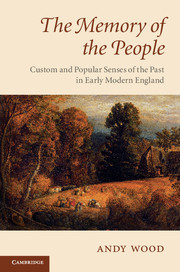Book contents
- Frontmatter
- Dedication
- Contents
- List of figures
- Preface
- List of abbreviations
- Introduction
- 1 Reformation, custom and the end of medieval England
- 2 Custom and popular memory
- 3 Rights, resources and social alignments
- 4 Topographies of remembrance
- 5 Textual and verbal ways of remembering
- 6 The politics of popular memory
- Epilogue.
- Bibliography
- Index
- References
1 - Reformation, custom and the end of medieval England
Published online by Cambridge University Press: 05 June 2014
- Frontmatter
- Dedication
- Contents
- List of figures
- Preface
- List of abbreviations
- Introduction
- 1 Reformation, custom and the end of medieval England
- 2 Custom and popular memory
- 3 Rights, resources and social alignments
- 4 Topographies of remembrance
- 5 Textual and verbal ways of remembering
- 6 The politics of popular memory
- Epilogue.
- Bibliography
- Index
- References
Summary
If thou art pore, thou art free: custom and vernacular memory in medieval England
In 1500, the yeoman Robert Carter of the Wiltshire village of Long Newnton sued his lord, the abbot of the nearby abbey of Malmesbury, before the recently formed court of Star Chamber. The abbot insisted that Robert was a bondman and that he therefore owed servile duties unless he paid a fee for his manumission. Having refused to accept this humiliating status, Robert had been beaten and jailed by the abbot’s retainers. Robert Carter’s case rested upon his claim that his grandfather, Thomas Carter, had, upon payment of a substantial fee, been manumitted by the abbey authorities some sixty years before. A former servant to Thomas Carter, the seventy-five-year-old husbandman John Newman gave evidence to the court. He said that he well remembered his master’s manumission. As Newman told the story,
his said maistre then bond to the house of Malmesberie was very desirous to be free ant to be manumised howbe it that he was very aged and had not many yeres to lyve, yet natheleas he had greate mynd that his heires and blode after him might be free and that he might be free [bef]or[e] he died and if he might bring that aboute it wold be more joifull to him then any worlelie goode. Such mynde this deponent knew him of bi thes words that he herd him speke divers and many times iiii or v yeres before his death.
Information
- Type
- Chapter
- Information
- The Memory of the PeopleCustom and Popular Senses of the Past in Early Modern England, pp. 43 - 93Publisher: Cambridge University PressPrint publication year: 2013
References
Accessibility standard: Unknown
Why this information is here
This section outlines the accessibility features of this content - including support for screen readers, full keyboard navigation and high-contrast display options. This may not be relevant for you.Accessibility Information
- 1
- Cited by
